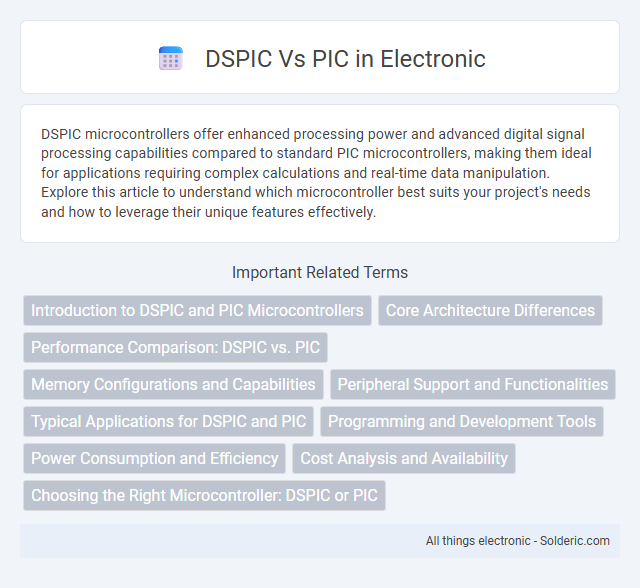DSPIC microcontrollers offer enhanced processing power and advanced digital signal processing capabilities compared to standard PIC microcontrollers, making them ideal for applications requiring complex calculations and real-time data manipulation. Explore this article to understand which microcontroller best suits your project's needs and how to leverage their unique features effectively.
Comparison Table
| Feature | dsPIC | PIC |
|---|---|---|
| Core Architecture | Enhanced 16-bit DSP core | 8-bit or 16-bit MCU core |
| Purpose | Digital Signal Processing & Control | General-purpose microcontroller |
| Performance | Higher MIPS with DSP instructions | Moderate MIPS, no DSP extensions |
| Instruction Set | DSP-optimized instructions | Standard MCU instructions |
| Applications | Motor control, audio processing, power conversion | Embedded systems, simple control, IoT devices |
| Memory | Larger program and data memory | Smaller memory footprint |
| ADC & Peripherals | Advanced peripherals tailored for DSP tasks | Basic peripherals for general use |
| Cost | Higher cost due to advanced features | Lower cost for simple applications |
Introduction to DSPIC and PIC Microcontrollers
DSPIC and PIC microcontrollers are integral components in embedded system design, with DSPIC offering advanced digital signal processing capabilities compared to standard PIC microcontrollers. PIC microcontrollers are widely used for basic control applications due to their simplicity, low power consumption, and cost-effectiveness. You can leverage DSPIC microcontrollers for complex tasks such as real-time signal processing, audio, and motor control, making them ideal for applications requiring high computational power.
Core Architecture Differences
DSPIC microcontrollers integrate a digital signal processor core with a PIC microcontroller architecture, enabling enhanced performance for complex mathematical computations and real-time signal processing. Unlike traditional PIC microcontrollers that primarily feature a simpler RISC architecture optimized for general-purpose control tasks, DSPICs combine DSP-specific instructions and hardware multiplier units to accelerate algorithms such as Fast Fourier Transform (FFT) and digital filtering. This core architecture difference makes DSPICs ideal for applications demanding high-speed arithmetic operations alongside standard embedded control functions.
Performance Comparison: DSPIC vs. PIC
DSPIC microcontrollers offer significantly higher processing power and advanced signal processing capabilities compared to standard PIC microcontrollers, enabling faster execution of complex algorithms and real-time operations. With 16-bit or 32-bit architecture, DSPICs provide enhanced computational efficiency and improved memory bandwidth, surpassing the 8-bit or 16-bit PIC models commonly used in simpler applications. This performance advantage makes DSPICs ideal for digital signal processing, motor control, and audio processing tasks where speed and precision are critical.
Memory Configurations and Capabilities
DSPIC microcontrollers offer enhanced memory configurations compared to PIC devices, featuring larger program memory sizes up to 1MB and expanded data memory to support complex digital signal processing tasks. PIC microcontrollers typically provide smaller flash memory, often ranging from 1KB to 256KB, suitable for general-purpose embedded applications with simpler memory requirements. The DSPIC architecture integrates optimized memory blocks for faster access and efficient handling of real-time data, enabling superior performance in applications requiring intensive computation and data throughput.
Peripheral Support and Functionalities
DSPIC microcontrollers offer advanced peripheral support, including high-speed ADCs, motor control modules, and enhanced communication interfaces like CAN and SPI, surpassing standard PIC devices. PIC microcontrollers typically provide basic peripherals such as timers, ADCs, UART, and basic PWM, suitable for simpler applications. Your choice between DSPIC and PIC should align with the required peripheral functionalities and the complexity of your embedded system project.
Typical Applications for DSPIC and PIC
DSPIC microcontrollers are typically used in applications requiring digital signal processing such as motor control, audio processing, and complex mathematical computations. PIC microcontrollers are suited for general-purpose embedded applications like home automation, sensor interfacing, and simple control systems. The choice between DSPIC and PIC depends on the processing power and specific functionality needed for the target application.
Programming and Development Tools
dsPIC microcontrollers offer advanced programming and development tools compared to traditional PIC devices, including support for DSP-related instructions and enhanced debugging capabilities. Your development process benefits from integrated development environments (IDEs) like MPLAB X, which provide robust code optimization and simulation features tailored for both dsPIC and PIC architectures. These tools ensure efficient programming workflows, enabling precise control over complex signal processing tasks with dsPIC or simpler control functions with PIC.
Power Consumption and Efficiency
dsPIC microcontrollers generally offer higher power consumption compared to traditional PIC microcontrollers due to their enhanced processing capabilities and digital signal processing features. However, dsPIC devices optimize efficiency by performing complex computations faster, allowing your application to enter low-power modes sooner and extend battery life. Choosing between dsPIC and PIC depends on your power budget and the level of processing efficiency required for your project.
Cost Analysis and Availability
DSPIC microcontrollers generally have higher initial costs compared to standard PIC microcontrollers, but offer enhanced processing power and integrated peripherals that can reduce overall system expenses. PIC devices are widely available with various models suited for low-cost, low-complexity applications, making them accessible for budget-conscious projects. Your choice depends on balancing upfront costs with long-term benefits and specific application requirements related to performance and availability.
Choosing the Right Microcontroller: DSPIC or PIC
Choosing between DSPIC and PIC microcontrollers depends on application requirements and performance needs. DSPIC microcontrollers integrate digital signal processing capabilities, making them ideal for complex computations in audio, motor control, and communication systems. PIC microcontrollers offer simpler architecture and lower cost, suitable for basic control tasks and low-power embedded applications.
DSPIC vs PIC Infographic

 solderic.com
solderic.com